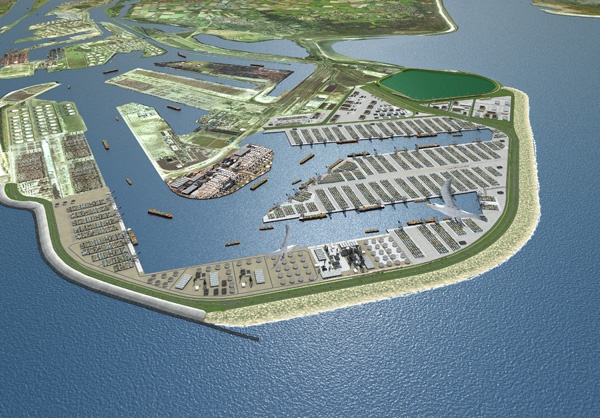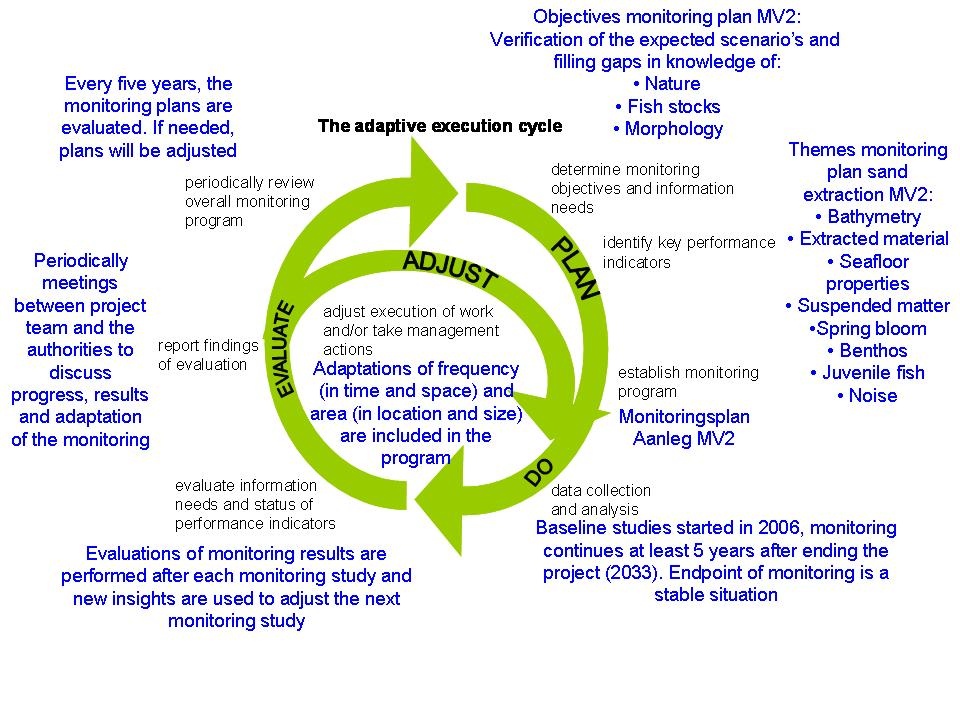Overview
Location: the Netherlands, Rotterdam port area
Date: 2008 – 2013 (first phase) / 2033 (complete project)
Involved parties: Client: Rotterdam Project for Mainport Development (PMR). Contractor: PUMA (Projectorganisatie Uitvoering Maasvlakte 2) consisting of Boskalis and Van Oord. Monitoring: IMARES Wageningen U, PUMA, Deltares; NIOZ, IECS, TNO, Rijkswaterstaat Dienst Noordzee.
Technology Readiness Level: 9 – actual system proven in operational environment
Environment: Sandy coasts
Keywords: adaptive monitoring, adaptive management, ecology

The Maasvlakte 2 (MV2) case is selected to investigate how adaptive execution monitoring could have helped and/or have added value to the project.
For the entire lifespan of the Mainport Rotterdam, extensive Monitoring and Evaluation Plans (MEPs) have been set up, such as the MEP Sand Extraction and the MEP Land Reclamation. Their goal is twofold: (1) verification of how actual effects related to an activity compare to expected scenarios, and (2) gathering data for filling important knowledge gaps. Every five years, all MEPs are evaluated. If needed, management plans are adjusted.
As the scope of the case study is marine sand mining, this historic case description of the Maasvlakte 2 focuses on the MEP Sand Extraction.
Project Solution
The objective of the monitoring plan is verification of the predicted scenarios and filling knowledge gaps on nature, fish stocks and morphology. Van Zanten et al., (2008) formulated a monitoring plan with the aim to verify the expected scenarios and fill the most important knowledge gaps. The monitoring plan, follows the adaptive execution cycle: every five years, the monitoring plans are evaluated. If needed, the management plans will be adjusted.

Important governance observations from this case study are:
- The authorities were open to new suggestions considering monitoring and allowed deviations from the initial permit requirements.
- Adequate information exchange between the authorities and the initiator is crucial.
Adaptive monitoring strategies
Considering adaptive monitoring strategies, there are two types of evaluation that can be distinguished:
- Structural evaluation of the complete monitoring plan (every five years);
- Evaluation of results within certain themes.
A separate working group conducts the monitoring program (van Zanten et al., 2008). Thereby, making it is possible to maintain an adequate information exchange with the authorities and the initiator (Mainport Rotterdam).
Periodic meetings are foreseen to discuss progress and results. Suggestions for adaptation of the monitoring plan can also be discussed at these sessions, e.g. to adjust the monitoring frequency, or to conducting additional measurements.
Based on the baseline monitoring results, adaptations of the initial monitoring plan have already been made for some elements:
Total suspended matter (TSM):
- The number of sampling locations has been reduced, because a link between TSM and juvenile fish could not be observed and spatial correlation showed a redundancy of locations; the number of locations could therefore be decreased from 100 to 50.
- The number of samples taken at each location has been increased, because temporal correlation was found to be only relevant in combination with more frequent sampling. The number of samples taken at each location has therefore been increased from 3 times (at 100 locations) in 2007 to 6 times (at 50 locations) in 2009.
Benthos:
- Benthos was monitored to determine the effect of increased TSM. Location and size of the benthos baseline monitoring area in 2006 have been changed, because of new insights into the TSM distribution; the second benthos baseline (2008) was adjusted to the TSM distribution (van Zanten et al., 2008).
Juvenile fish:
- Monitoring of this aspect has ended, because no relationship between TSM concentration and juvenile fish could be determined.
